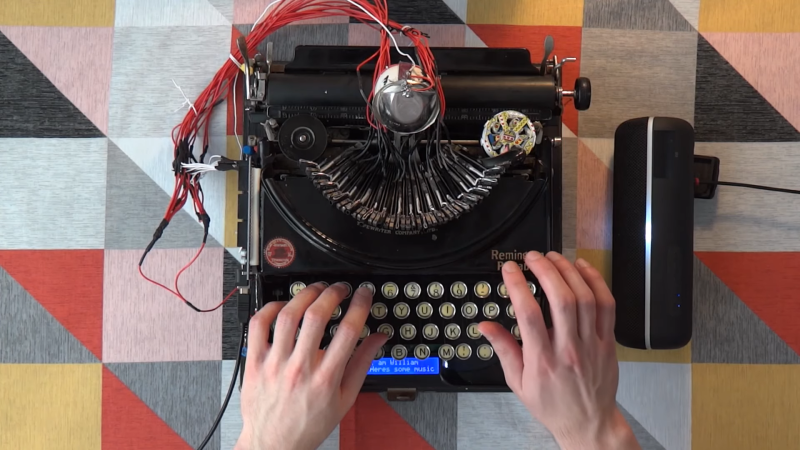We have seen a fair share of unusual items being turned into musical instruments. Luckily, with a little bit of hacking it is possible to turn almost anything into a MIDI controller. [William Sun Petrus] just converted a 1920s typewriter into a drum machine and delivers a hell of a live performance on it.
The build is rather simple, all [William Sun Petrus] needed was an Arduino Mega and lots of wires to convert a hundred-year-old Remington typewriter into a MIDI controller. Whenever a key is pressed the hammer hits a metal plate at the center of the typewriter and closes the contact between one of the Arduino’s IO pins and the 5 V rail like a regular push button. The Arduino code is based on the MIDI library sending commands to a PC which is running Hairless MIDI and Ableton. As sort of a gimmick, [William Sun Petrus] included an LCD screen which shows a line from Green Eggs and Ham by Dr. Seuss every time a key is pressed.
Interestingly, the latency due to the hammer’s travel time does not disturb [William Sun Petrus’] live play. To calm the skeptics in the comments he also released an unedited version of the video to prove that the performance is real and an instructional video on how to play his beat note by note.
Other unusual MIDI controllers include a bandoneon accordion or this English concertina.
Video after the break.
[Thanks to Markus for the tip]
















Say what you will, that’s not the real deal.
That is:
https://www.youtube.com/watch?v=QBRueH_9fcc
and of course Leroy Anderson:
https://www.youtube.com/watch?v=p2QCqM83vyE
To whoever “programmed” this comments system: There are TWO youtube links in the comment above. The first one shows more of a “drum machine” style typewriter use than Anderson’s solo instrument.
He’s using the wrong typewriter for the typewriter symphony, should have a big old Imperial or something with an end of line bell, and you can slide all the tab stops out the way either side so you can hit the tab key to make the carriage go all the way to the end and trigger it when you want.
I have several old typewriters, some considerably older than “standard qwertz/y” layout – and believe me, that bell is unreliable on most of them. Most renditions of Anderson’s symphony I have seen use a separate bell for that reason.
Ah, but what about an Imperial model 50, designed for the situation where you’d have to beat a rampaging elephant to death with it, before you finished typing up your rubber company report. The front slid out so you could hose out the bits of skull easily.
By “not reliable” I meant “you cannot rely on the bell to ring audibly when you need it, it may just be slightly more slient than required – or slightly late – or it could ring BEFORE you need it”.
When talking about a musical instrument, being able to “control” it is more important than beating elephants with it.
I have a heavy one with a bell. The carriage is heavy, so heavy that the delay between pressing the tab and the bell sound is really difficult to predict. Not to mention that ramming such carriage against the end stop from anywhere but the very end of the line will probably destroy something eventually.
Love this one! Such an iconic idea